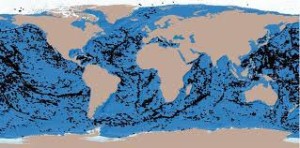Seamounts *
Seamounts are mountains that rise from the ocean floor but do not reach the water’s surface. However, during the last Ice Age when the level of the oceans were much lower a considerable number of these seamounts would have existed as islands that in many cases would have been quite substantial in area. Many of the thousands of seamounts around the world are of volcanic origin.
The Atlantic is home to many named seamounts, three of which are called Atlantis, Cruiser and Great Meteor. Bruce Heezen et al published a short paper in 1954 describing these flat-topped features(k).
The Ampere and Josephine Seamounts, 450 miles west of Gibraltar were investigated by Soviet oceanographers, including Andrei Aksyonov, in 1970s (f)(j). On examination of their underwater photographs, they discerned what appeared to be ‘walls, stairs and other artificial stonework’ at a depth of around 200 feet, far less than the drop in ocean levels that occurred during the Ice Age. Egerton Sykes was convinced that these reports and associated photos revealed remnants of Atlantis or one of its colonies. Alexander Gorodnitsky also chose the vicinity of the Josephine and Ampere Seamounts as the site of Atlantis(j).
Josephine Seamount was claimed once again as the site of Atlantis by ‘Paulo Riven’ in 2003(b).
However, such claims must be treated with great caution until further corroboration is received. One Internet commentator has suggested(a) that the Amperes/Gettysburg Seamounts were once the location of a substantial island, containing Atlantis, which had been destroyed by asteroidal showers, combined with a nearby geological fracture. This same writer dates this disaster to 6482 BC.
Appropriately there is an Atlantis Seamount with its ‘Lost City’ hydrovents, where recent research(c) has drilled for samples of the lowest level of the Earth’s crust, which rests on the mantle.
Horseshoe Seamounts, is an extensive submerged chain of mountains north of the island of Madeira, in the Atlantic, opposite Gibraltar. Frank Joseph suggests[102] that the 6,000 sq. miles of this seamount was large enough to contain Plato’s Atlantis. Joseph has also written an article(g) on the Russian claims of discovering human artifacts on Ampere in the 1970’s. This should be read in conjunction with a short piece from Jason Colavito(h).
Another possible candidate was the Great Meteor Seamount, which was apparently shown on a 1707 map by French cartographer, Guillaume Delisle, as Saint Brendan’s Isle(e).
Paul Dunbavin has added a paper(i) on his website in which he discusses the Ormonde and Gettysburg Seamounts, which are opposite the Strait of Gibraltar, and their possible relevance to the Atlantis story, as suggested by some. Dunbavin concludes that “It should be apparent that even if these two islets did appear above the sea during the Holocene then they cannot have been Atlantis. They are simply too small to hold all the features described.”
The Azores, Canaries and Madeiras, in the Eastern Atlantic would have had larger landmasses exposed before the end of the last Ice Age because of the lower ocean levels. These archipelagos, together with seamounts, currently submerged, would have offered a substantial area of dry land, in a hospitable climate, on which a civilisation could have developed and flourished.
Another suggested connection between seamounts and Atlantis is made on a website(d) which nominates Dacia Seamount as its location with a series of interesting images and a lot of speculation.
(a) https://en.wikipedia.org/wiki/Talk:Atlantis/Archive_1
(b) https://tribesofatlantis.blogspot.ie/p/atlantean-chronos-by-paulo-riven.html
(d) https://www.flickriver.com/photos/10749411@N03/sets/72157625118289098/
(e) Redirecting (journalofthebizarre.blogspot.com)
(f) https://trove.nla.gov.au/ndp/del/article/110939505?searchTerm=Atlantis discovered&searchLimits=
(h) https://www.jasoncolavito.com/blog/the-soviet-search-for-lemuria-and-atlantis
(i) https://www.third-millennium.co.uk/submerged-islands-gibraltar-strait
(j) http://atlantisonline.smfforfree2.com/index.php/topic,13305.0.html
(k) Bulletin of the Geological Society of America- Vol.65, 1954

